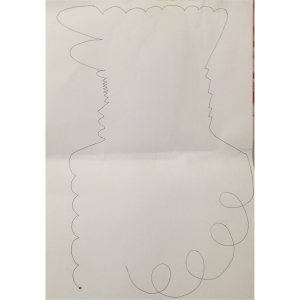This week I opened my eyes. To the space, to the movement and to the people.
Taking part in the tasks that involved a partner, really enabled me to do this. When thick skinning, I found myself constantly aware of what my partner was doing, so that I could actively follow this. In a reading, it talks about empathy as “the link between dancers in contemporary improvisation” “co-built relational activity that emerges from dance improvisation” (Riberiro and Fonseca, 2011, 81), and later goes on to say that in an improvisation, an “empathic choreography occurs based on collective intelligence that generates a temporary structuring of movement sequences built at the present moment, without the mediation of words.” (Riberiro and Fonseca, 2011, 81). I found that this summed up my experience when working in a partnership, as we actively had to collectively generate a movement sequence, that was only temporary, without using our voices or any signals.
When impulsing, it was easy to spot which parts of the body we found it easiest to send the impulse with. These tended to be the hands, legs, arms and head.
I guess this was because it is the easiest and most habitual way to send an impulse, and perhaps this made the improvisation in partners habitual.
To change this, we had to change the part of the body we impulsed with, which opened various new opportunities for exploring new movement. I felt like the movement became more fluid, as we were not looking for how we could impulse with our hand when the other person was behind. The movement became more connected, and so did me and my partner. We were working together to find the most interesting way to impulse during our improvisation, and this made it an interesting task.
Thomas Lehmen’s Functionen.
I really enjoyed this score, I constantly found myself hesitating as to whether I should join in or not.
Cycle 1:
A person enters the space with material.
A second person enters to interpret the material.
A third person enters to manipulate both the interpreter and the material creator.
A fourth person enters and observes everything happening in the space.
A fifth person enters, to mediate everything in the space.
Cycle 2:
Anyone can enter the space in any role.
If you are in the space and want to change roles, then you must first leave the space.
Personally, I found it difficult to enter in the first cycle, as I was unsure as to what role I wanted to take part in. However, in the second cycle, I felt more confident in my ability to perform in any role that I chose.
I found myself constantly drawn towards observer and material. I liked the idea of bringing new ideas into the space, as well as observing the growing ideas.
The Jam.
We again focused on Thomas Lehmens Functions,but this time, the movement came from our own life stories.
I found this extremely interesting, however I felt hesitant to go in and interpret anyone else’s story, as I felt that I was intruding on their personal life events.
Overall, this week I felt less confident that other weeks, however i’m still not entirely sure why.
- Ribeiro, M. M. and Fonseca, A. (2011) The empathy and the structuring sharing modes of movement sequences in the improvisation of contemporary dance. Research in Dance Education, 12 (2) 71-85.
- Husemann, P. (2005) The Functioning of Thomas Lehmen’s Funktionen. Dance Theatre Journal, 21 (1) 31-35.

Recent Comments